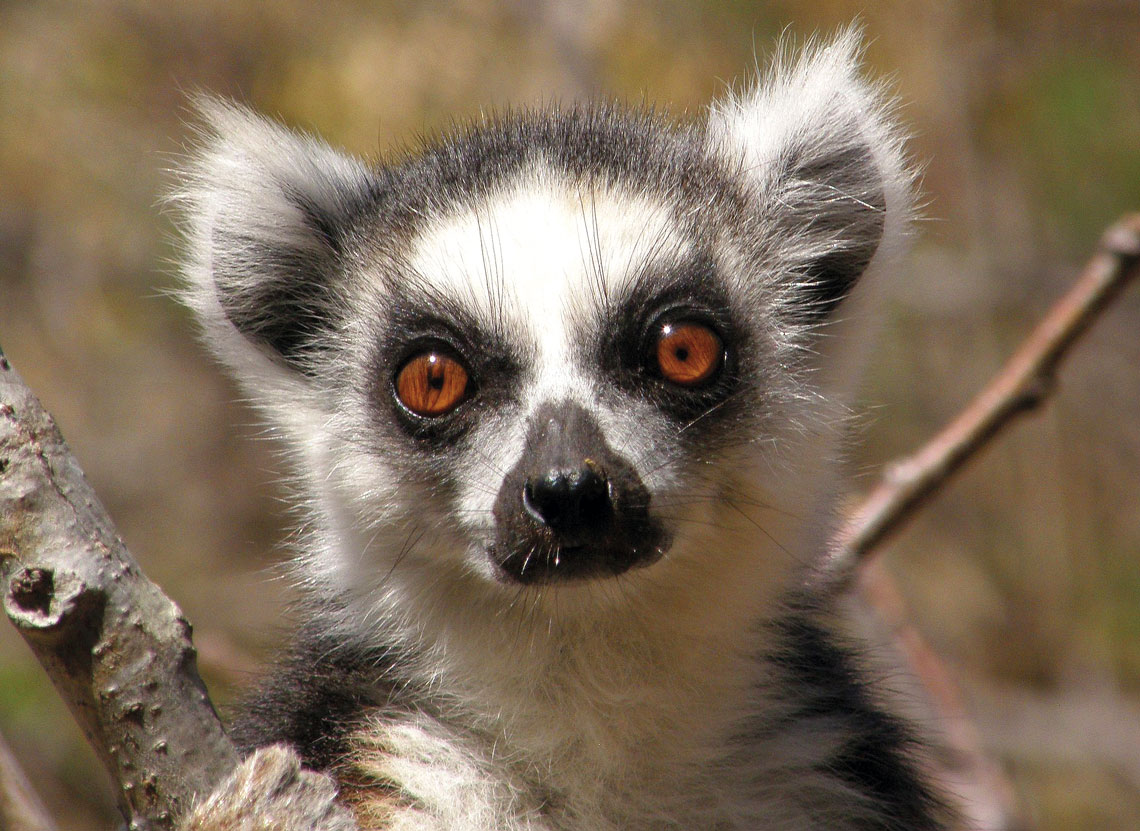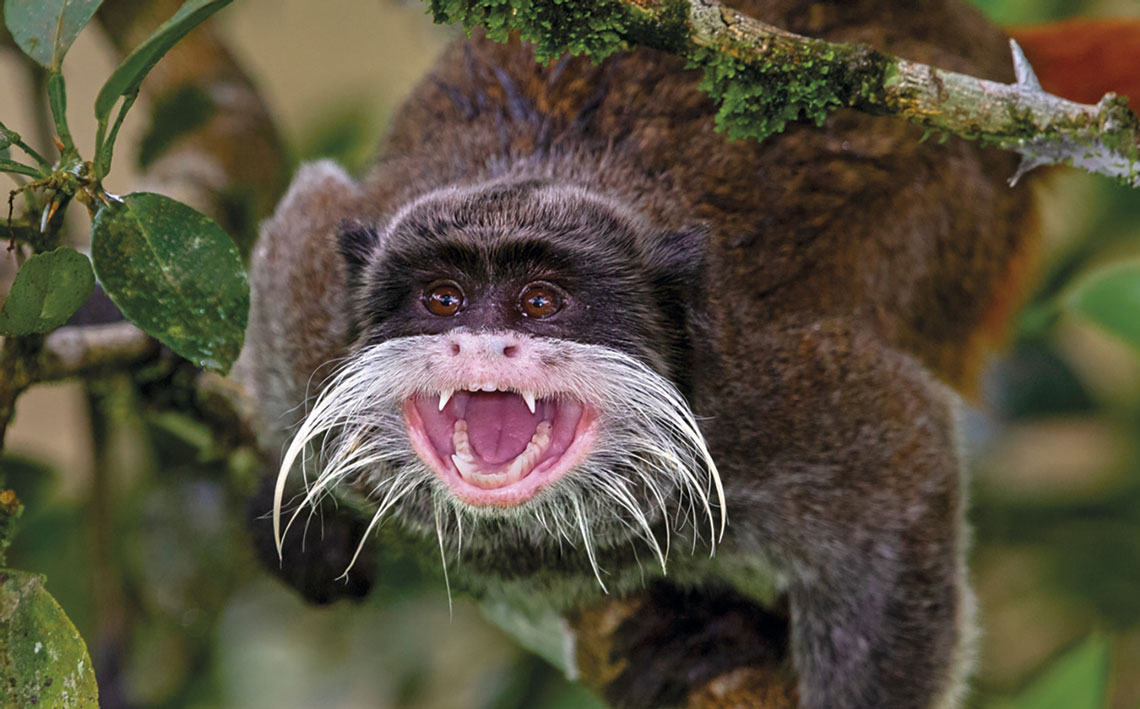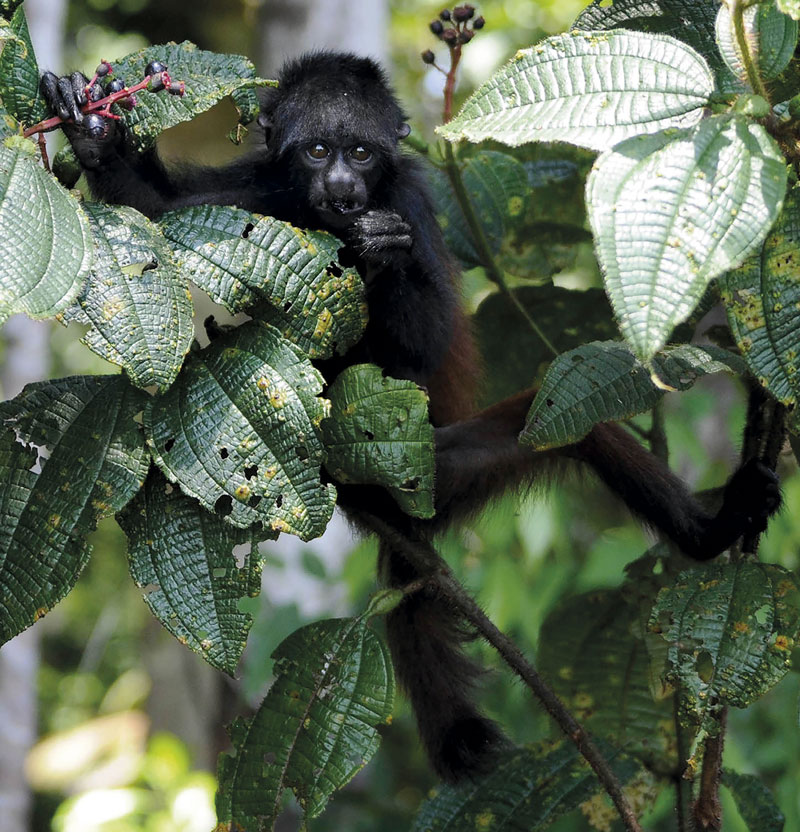With fresh data from the newly sequenced genomes of more than 800 primates of 233 different species, researchers based in 24 countries are uncovering fresh conclusions about this fascinating animal group, which counts humans as members. Their findings about evolution, lifestyle, and health are reported in a series of eight articles in a special edition of Science. Progress toward the central goal of the project — to harness evolutionary insights as medical tool — has been promising although still incipient. Meanwhile, the research has also helped to broaden scientists’ understanding of primate evolution and biology.

Marcelo SantanaThe golden-faced saki (Pithecia chrysocephala), native to the northern banks of the Rio Negro, is classified as a least-concern speciesMarcelo Santana
“I was most surprised by the finding that genetic diversity doesn’t correlate with a species’ risk of extinction,” notes Jean Boubli, a primatologist affiliated with the University of Salford in the UK. He coauthored the opening article in the special edition and coordinated efforts to obtain samples from the collections of several Brazilian institutions: the federal universities of Viçosa (UFV), Amazonas (UFAM), Rondônia (UNIR), and Mato Grosso (UFMT), the Brazilian Institute for Amazon Research (INPA), the Mamirauá Institute, and the RedeFauna network. “Approximately 30% of the samples used in the study came from our group,” he says. However, only a fraction of the total amassed samples were featured in the Science article. Since then, hundreds more samples have been sequenced, creating a robust database for future analyses. Boubli believes the study’s high species coverage would not have been possible without the participation of the Brazilian researchers and the samples collected over several decades of fieldwork, all well preserved in zoology museums.
The DNA sequencing was conducted by genomics firm Illumina, based in California. The original objective was to compare humans with their closest kin to gain insights into various diseases. “We realized that data on primate diversity held the solution to unraveling the human genome,” wrote American medical geneticist Kyle Farh, Illumina vice president for artificial intelligence and a key figure in the project, in an email to Pesquisa FAPESP. “Without analogous species to guide us, it can be very difficult to interpret the human genome.” An evolutionary perspective can provide a wealth of valuable information — comparing analogous genes in other species can reveal, for instance, mutations that have a more pronounced impact on health, and what regions are more susceptible to natural selection. “If a gene appears to be linked to a human disease but is functional in other primate species, chances are it’s not the root cause,” explains Boubli.

Rebecca Still | Marcelo SantanaThe bald uakari (Cacajao calvus, left) and the Peruvian spider monkey (Ateles chamek, right), both classified as vulnerable on the IUCN Red List of Threatened SpeciesRebecca Still | Marcelo Santana
However, gaining a better understanding of other primates was a separate goal in its own right. “We’ve developed the most robust phylogenetic tree for primates to date,” says Boubli, adding that this significant contribution — an improved genealogy of kinship among species and their chronological emergence from shared ancestors — owes much to the work of evolutionary scientist Robin Beck, also from Salford. “He incorporated numerous fossils, refining the dating estimates.” The research findings indicate, for instance, that the split between chimpanzees and humans occurred slightly earlier than previously estimated, around 9 to 7 million years ago. There were species, like certain howler monkeys, which had not yet been sequenced and have now found their rightful place in the genealogical tree.
The new findings also provide insight into how ecology and behavior influence the genetic diversity of species. For instance, genetic diversity is lower in animals where reproductive dynamics involve a single male mating with multiple females. Patterns of activity (whether animals are diurnal or nocturnal, and whether or not they spend long, continuous periods in activity) and the climate conditions to which animals are adapted are other factors that have been shown to be relevant.

RmedinaThe ring-tailed lemur (Lemur catta) from Madagascar is at risk of extinctionRmedina
Diversity has also been found to decrease from south to north. The genetic richness of the Southern Hemisphere is likely inflated by the diverse range of lemur species, which are endemic to the island of Madagascar. This finding is paradoxical, as it was previously understood that the more genetically diverse, the fitter the species. According to Boubli, this is explained by these animals having historically had very large populations, a detail that would come as no surprise to fans of the Madagascar film franchise. Despite this, many of these species are facing a serious risk of extinction due to human activity. “The population decline is recent from an evolutionary perspective, given that human populations only established themselves in certain parts of Madagascar around a thousand years ago.” The situation is different for New World primates — such as in Brazil — where life in smaller groups and populations is a natural biological trait. The study did, however, identify an abnormal population drop in a Central American howler monkey species, Alouatta palliata, approximately 10,000 years ago. “One hypothesis is that it might have been impacted by pre-Columbian civilizations in the region, such as the Mayans and Aztecs,” suggests Boubli.

Marcelo SantanaThe emperor tamarin, or Brockway monkey (Saguinus imperator), is at a low risk of extinctionMarcelo Santana
Estimating a species’ historical population size can aid in predicting its future fitness, he says. “A species that has experienced adverse climate conditions resulting in population reduction, such as glaciations or droughts, might have a greater ability to withstand today’s climate change,” he argues.
The articles in the special edition are wide-ranging. One article explored genetic innovations in the simian lineage —which includes humans — that drove diversification and adaptation to changing environments. The evolution of social organization in Asian colobines, which include Indian langurs, was the subject of an article describing the impact of glaciations on the neuro-hormonal regulation of the inclination toward communal living. Another study found that the Gray snub-nosed monkey (Rhinopithecus brelichi) of China had a hybrid origin, from two distinct species.

Jan DungelThe black-headed uakari (Cacajao hosomi) was described by Boubli in 2008Jan Dungel
And how might the 809 sequenced genomes prove valuable for human-health research? One of the Science articles, coauthored by Brazilian researchers, discussed the challenges of compiling sufficient data to train machine-learning models, and reported on progress made in predicting clinical parameters. Another article explored how the detection of rare genetic variants can aid in predicting susceptibility to disease in the field of precision medicine, and in developing drug targets. Differentiating between harmless and harmful genetic variants, and assessing the magnitude of their effects on humans, has previously been a challenge. “The primate data enabled us to develop a deep learning network, trained on the basis of natural selection,” explains Farh. “While its architecture is similar to ChatGPT’s, it is the first initiative of its kind to be trained using this approach, and holds enormous potential for personalized medicine.” One unexpected finding was that 97% of the analyzed human genomes, even among healthy individuals, had pathogenic variants that could have adverse impacts on clinical conditions.
“They used phylogenetic conservation to draw inferences about pathogenicity,” explains Diogo Meyer, an evolutionary scientist from the University of São Paulo (USP) who was not involved in the study. This means that when DNA segments remain unaltered throughout evolution, the trait they are associated with becomes less tolerant to change. When a mutation occurs, there is a significant risk that it will cause disease. For a project like the one led by Illumina, biodiversity provides a wealth of valuable data to feed into medical algorithms. “Economically valuable applications for evolution have led to unexpected collaborations between evolutionary scientists and clinical geneticists,” says Meyer.

Marcelo SantanaSaimiri cassiquiarensis was identified as a species of tamarin in 2009Marcelo Santana
According to Farh, the project is just beginning. “With so many species still unexplored, we’re in a race against time to study them before they face extinction.” Jean Boubli highlights the study’s value for conservation efforts. During meetings of the International Union for Conservation of Nature (IUCN), which determines species’ extinction risk, estimates often rely on researchers’ expertise when data is limited. “Now we have a new genomic tool to evaluate population health.” He plans to expand on this research by sequencing other Brazilian vertebrates, in collaboration with geneticists Maria Rita Passos Bueno and Mayana Zatz, both from USP, and with funding from Illumina.
Scientific articles
KUDERNA, L. F. K. et al. A global catalog of whole-genome diversity from 233 primate species. Science. vol. 380, no. 6648, pp. 906–13. june 2, 2023.
GAO, H. et al. The landscape of tolerated genetic variation in humans and primates. Science. vol. 380, no. 6648. june 2, 2023.


